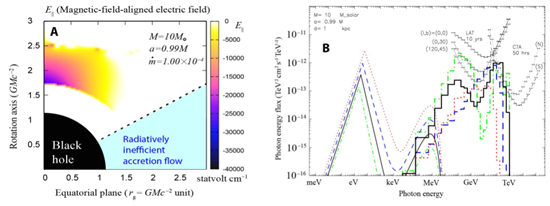|
Image Credit: Hirotani et al. (2018)

(A)
Side view of a BH magnetosphere. Photons are emitted from infrared to soft gamma-ray energies by the hot gas falling toward the BH in the equatorial, accretion
(cyan) region. The soft gamma-rays collide each other to create electron-positron pairs in the polar funnel (white region). The created pairs are separated and accelerated into the opposite directions by the electric field $E_|| that is exerted along the magnetic field lines
(in yellow-purple colored region). The outwardly accelerated electrons have ultra-relativistic energies to emit copious hard gamma-rays.
(B)
Spectra of the hard gamma-rays. The four thin curves (on the left-hand side) corresponds to the spectra from the equatorial inflow at four discrete mass accretion rates onto the BH:
the red dotted, blue dashed, black solid, and green dash-dotted curves correspond to the accretion rate of 3.2e-3, 1.8e-3, 1e-3 and 5.6e-4, in the unit of the so-called "Eddington accretion rate." The distance is assumed to be 3260 light years. The thick four lines (on the right-hand side) denote the spectra of the hard gamma-rays emitted from the lepton accelerator (yellow-purple region in panel A) at each corresponding accretion rate. In the upper right corner, the gamma-ray detection limits with the current and near-future gamma-ray telescopes are denoted by the thin solid, dashed, and dotted curves with the labels LAT, CTA (South), and CTA (North).
|
The Imaging Atmospheric Cherenkov Telescopes (IACTs) provides a wealth of new data on various energetic astrophysical objects, increasing the number of the detected hard gamma-ray sources above 0.1 tera-electronvolts (TeV=10^12 eV) from 7 in the 20th century to more than 200 in this century. Among the presently operating three IACTs, High Energy Stereoscopic System (HESS) has so far discovered 42 new TeV sources along the Galactic Plane, 22 of which are still unidentified. The nature of these unidentified TeV sources may be hadronic origin, which predicts an extended morphology of the hard gamma-ray image. So far, 38 TeV sources are found to be associated with dense gaseous clouds out of the 49 Galactic giga-electronvolt (GeV=10^9 eV) sources covered by the radio observations at the wavelength of 12 mm.
There is, however, an alternative scenario for the TeV emissions from gaseous clouds. In the Milky Way, molecular gas is mostly located in giant molecular clouds, in which massive stars are occasionally formed. If a massive star evolves into a black hole (BH) and encounters an adjacent molecular clouds, it accretes gases. The captured gases flow in the equatorial region (cyan region in panel A of figure) and fall onto the BH. When the mass accretion rate is low enough, a vacuum magnetosphere develops in the polar funnel, and an electric field, E||, arises along the magnetic field lines by virtue of the general relativistic effect (specifically, the so-called “spacetime frame dragging effect”) around a spinning BH in a charge-starved magnetosphere. Accordingly, electrons and positrons are accelerated into ultra-relativistic energies to emit hard gamma-rays from GeV to TeV. In this leptonic scenario, the gamma radiation takes place only near the BH; thus, their gamma-ray image should have a point-like morphology. The predicted spectra of such hard gamma-rays are depicted by the four thick curves for discrete mass accretion rates in panel B of figure. It follows that the hard gamma-ray spectrum shows a turnover around TeV and the luminosity anti-correlates with the accretion rate. It forms a striking contrast to the shock-in-jet scenario (an alternative gamma-ray emission scenario from BHs), which predicts a single power-law spectrum extending well beyond TeV and a correlation between the hard gamma-ray and infrared fluxes. What is more, if the accretion rate fluctuates at the dynamical time scale (e.g., the light crossing time of the event horizon), the hard gamma-ray flux is predicted to vary at similar time scales in the leptonic scenario, while much longer, independent variations are expected in shock-in-jet scenario, or no short variations are expected in the hadronic scenario. On these grounds, we can discriminate the TeV gamma-ray emission mechanisms from gaseous clouds by observing
(1) the morphology of the image,
(2) gamma-ray spectral shape,
(3) anti-correlation/correlation between the gamma-ray and infrared fluxes, and
(4) the time variability properties. |
 asiaa.sinica.edu.tw Media Request: epo
asiaa.sinica.edu.tw Media Request: epo asiaa.sinica.edu.tw
asiaa.sinica.edu.tw 